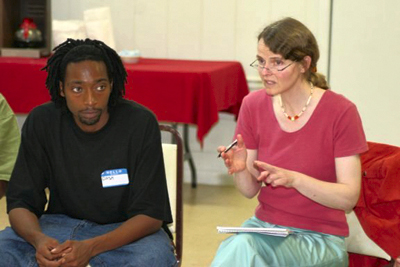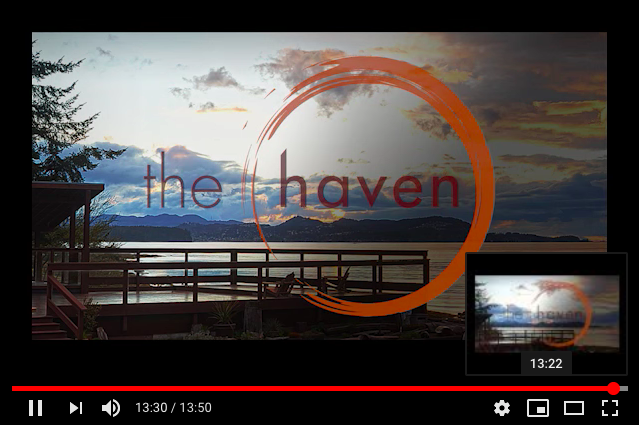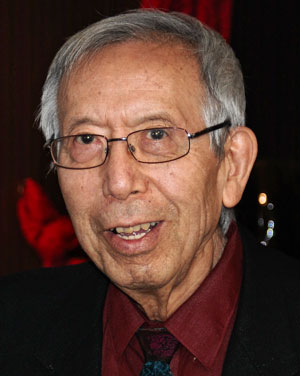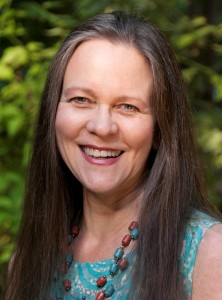Story Water/Story Wisdom
By Margo McLoughlin Margo is leading Storytelling for Reinventing the World at The Haven, November 4–6.
A version of this article appeared in “Giving and Receiving,” the Summer 2011 issue of Parabola Magazine.
A story is like water
that you heat for your bath.
It takes messages between the fire
and your skin. It lets them meet,
and it cleans you!
Very few can sit down
in the middle of the fire itself
like a salamander or Abraham.
We need intermediaries.
These lines come from “Story Water”, a poem written by the thirteenth century Sufi poet and mystic Jelalludin Rumi.[1. Coleman Barks with John Moyne, trans., “Story Water” in The Essential Rumi. (San Francisco: HarperSanFrancisco, 1995), p. 171.] The poem has become a touchstone for me in the work I am doing with stories — asking them to be intermediaries; putting them to work in the service of communities. I believe it is the distilled wisdom of folktales, told and retold over centuries, that makes them fluid and mirror-like, naturally flowing from one cultural context to another, easily reflecting the issues and concerns of the place where they land.
In 2003 I was completing my Master of Divinity at the Harvard Divinity School when I was hired along with other researchers to gather world folktales of generosity for the John E. Fetzer Institute, a non-profit foundation based in Kalamazoo, Michigan. The initial phase of the project was research-driven — to see how different world cultures teach the very basic and essential quality of generosity, in all its manifestations, from the sharing of resources to forgiveness, collaboration, and wise leadership. After combing through folktale collections from Harvard’s many libraries and corresponding with scholars and storytellers, I put together a database of over two hundred tales, many of which are now available to educators and the general public on the Council of Michigan Foundations’ website.[2. www.learningtogive.org/materials/folktales] Gathering this material was in itself useful, and making it available to educators and the general public affirmed its potential in the field of education.
The second phase of the project led my colleagues and me to exploring the potential of these stories to invite a level of discussion that was both meaningful and productive. What if these stories of generosity could be used in community settings to build relationships and spark dialogue? What healing potential did the stories offer for professions with a high degree of burn-out such as politics, education, medicine, and social justice?
In 2005 the Fetzer Institute’s “Generosity of Spirit” project launched a series of pilot retreats to find out how these stories might serve in different settings and with different groups, from congressional staffers to medical faculty at the University of Indiana and from teachers in Michigan to social justice activists in Mississippi.
What we discovered is that the story “goes to work” on at least three levels. First, the shared experience of hearing the story builds relationships in an easy, non-confrontational way. Second, the images in the story open the imagination of the listener and suggest new perspectives, new ways of being. Rather than teaching in a didactic manner, the folktale’s lessons reach the heart of the listener indirectly, entering through the imagination, as well as through the body’s silent collaboration in the unfolding events of the narrative. Third, the opportunity to reflect on the story together offers the story circle’s participants a rich opportunity to learn about each other.
One of our first Generosity of Spirit retreats took place in Indiana at Indiana University’s School of Medicine, where research and innovation in the field of patient-centered care had been underway for several years. We had initially interviewed senior faculty and administrators to understand what were, for them, the most current, perplexing, vital issues or challenges – as well as their most potent gifts and strengths – so we could more accurately determine which stories we might choose to use at various points during our story circle. For two days my colleagues (Wayne Muller and Mark Nepo) and I gathered with approximately thirty senior medical school faculty including the president of the Regenstrief Institute for Health Care, Dr. Tom Inui – who, along with Dr. Rich Frankel, Senior Researcher at the Institute, served as our hosts.[3. Established in 1969 by philanthropist Sam Regenstrief on the Indiana University – Purdue University Indianapolis campus, the Institute is supported by the Regenstrief Foundation and closely affiliated with the Indiana University School of Medicine.]
Under the leadership of Drs. Inui and Frankel, the medical school had chosen to radically change its admission policy, increasing the value of the applicant’s presence, personal ethic, and relational skills, and less value to the practice of solely grading academic performance. They hoped to admit applicants whose “way of being human” in the interview would reveal their potential to show empathy, care, and compassion as a physician, rather than admitting students who may have been drawn to the profession more by the prospect of future income or status. The theme of generosity of spirit spoke directly to the philosophy and culture they wished to embody as professors, staff, and physicians.
The stories we used in Indianapolis were particularly apt: “The Origin of Different Water Animals” and “A Drum,” both folktales from India.[4. “A Drum” is a Telugu story collected by A. K. Ramanujan and published in Folktales from India: A Selection of Oral Tales from Twenty-two Languages (New York: Pantheon Books, 1991), 226-27. “The Origin of Different Water Animals” is found in John Elder and Hertha D. Wong, ed. Family of Earth and Sky: Indigenous Tales of Nature from Around the World (Boston: Beacon Press, c1994).] The first story is about extremes of giving, an issue that is very familiar to physicians. “A Drum” is about the circular nature of generosity: How, when it is understood and expressed in a certain way, it is much more than a one-to-one interaction—it creates a flow of energy that circulates through the community, affecting more than one other person and ultimately benefiting the individual who initiated the first gift.[5. “A Drum” beautifully reflects the lessons that Lewis Hyde describes in his seminal book The Gift: Imagination or the Erotic Life of Property (New York, Random House, 1983).] But more than this, generosity generates meaning: Lewis Hyde, in his book The Gift touches on what I believe is the essential element in gift exchange, or any act of generosity, and that is the creation of meaning. He writes: “Gifts, given or received, stand witness to meaning beyond the known, and gift exchange is therefore a transcendent commerce, the economy of recreation, conversion, or renaissance.”[6. Lewis Hyde, The Gift, p.193.] Walt Whitman’s daily visits to Carver Hospital in Washington, D.C., during the Civil War, where he dispensed gifts to the young soldiers — small gifts of money, peaches, ice cream, clean shirts, and handkerchiefs, as well as the gift of his interest, concern, and care — were remembered by him as the happiest times in his life. In giving his care and affection, and in receiving gratitude and appreciation, he found a depth of meaning he hadn’t known before.
If we give without expectation of return, we may be surprised by the blessings that flow back to us. As we have discovered when we share these stories in different settings, every listener brings a unique perspective to interpreting the story. In Indianopolis, one of our retreat participants was from India and had grown up with the story. A professor of linguistics, she shared with us how the story had been a teaching tale for her in two ways: First it was about recognizing the truth of abundance, that there is always more available to us in the world than we realize, and second, that even when we think we have nothing, we may have something to give that is just what someone else needs at that moment.
On the second day of the retreat Rich Frankel told us how the first day of being in the circle had affected his morning: “I started the day with surgery students at 7:00 a.m. asking myself, ‘What’s trying to happen here?’ There was a luminous quality present, because of the openness of this process. The students started to come forward with their own stories. Then, I had an admissions interview. I found myself being open to the story this applicant wanted to tell.” Through the experience of hearing these stories of generosity, Dr. Frankel had been reminded that personal narratives are also gifts that we give and receive. Generosity is present on both sides of the exchange. And, in the field of healthcare, the way a narrative is received can have a profound impact on an individual’s healing.
In Mississippi, at two different weekend retreats, the circle was composed of people from Greenwood and Ittabeena, in the Mississippi Delta. These are folks who care deeply about the place they call home. Some of them grew up in the Delta. Some left and have returned to retire. Others have arrived here from elsewhere. They describe Greenwood as a place that is still racially divided, with the river separating the more prosperous part of the city from Baptist Town, an African-American neighborhood with high unemployment rates. Besides geographical divisions there is also division in the education system. The public schools are under-funded and see only a small percentage of their students complete their high-school education. Pilloh Academy, the predominantly white institution that was founded in the Sixties during the era of integration, sends most of its graduates on to university.
Under the auspices of the Winter Institute for Racial Reconciliation in Oxford, Miss., these individuals had come to a lakeside resort in Louisville to attend a pilot “Welcome Table” retreat, a chance to see if the Story Circle model might be of use to them in their work of building community.[7. Other collaborators on this project are the Fetzer Institute and the Kellogg Foundation.] In the circle was a fire-fighter chief, a retired college professor, a retired physician and member of the National Guard, a high-school student, a pastor, a member of the Chamber of Commerce, and several other members of the community.
Among other stories, I told “The Antelope Birth,” one of the Buddhist Jataka (narratives that tell of the Buddha’s former lives). The story resonated strongly here because it’s about the art of collaboration. Three very different creatures work together to help each other.
“They recognized each other’s unique skills,” said Bill, a retired college professor and former high school teacher and basketball coach.
“They took a risk,” said another participant.
“They didn’t procrastinate. They weren’t waiting for someone else to come along and tell them what to do.”
“They got to know each other by telling stories and then, when a crisis happened, they were ready to work together.”
Each of these reflections demonstrates the power of the story as a fluid metaphor, one that “is only waiting for a new context to reveal new meaning.”[8. A. K. Ramanujan, ed. Folktales of India: A Selection of Oral Tales from Twenty-two Languages (New York: Pantheon Books, 1991), p. xxii.]
In Buddhist India the narrative is about the embodiment of loving-kindness or friendliness. When he is caught in the hunter’s leather snare, the antelope’s loyal friends, the turtle and the woodpecker, set to work to free him. The woodpecker uses his wings to startle the hunter and slow him down, while the turtle uses his sharp beak to cut and chew the leather snare. The antelope escapes the snare but the turtle, too exhausted by his exertion, cannot move fast enough to elude the hunter when he returns. Finding his snare empty, the hunter is at first disappointed, but then decides that a turtle is just as good as an antelope. He collects the turtle, placing him in his leather pouch. The antelope, looking back as he runs down the trail, sees that his friend has been captured and returns to rescue him.
In the story the enemy is a hunter, just doing what hunters do. But in Mississippi, the enemy is complacency, a culture of sometimes subtle and often overt racism.
When I told the story at a second Welcome Table retreat for participants from Greenwood, held in Louisville in January 2010, it elicited similar but slightly different responses. As I listened to the participants responding, I became aware that each listener had their own reflections, as they listened to the story, but as soon as they began to share them, they were also building upon each other’s ideas. The story’s meaning was extended and deepened by the discussion.
“It speaks to where we are,” said one person. “We’re such a diverse group.”
“They picked up each other’s slack,” said another.
Alice, a former corrections officer, offered these thoughts: “[The animals] shared the same space. What happened to one affected the other. They came together.”
Dash, a young African-American man in his mid-20s, who grew up in Chicago, talked about how the story showed each of the characters learning to try something that wasn’t necessarily part of their nature: “The turtle told stories that were long and slow, but he had to work quickly to free the antelope. The antelope, who was used to moving around quickly, had to be patient. The woodpecker had to show bravery. He was on top of his game.”
Another listener said, “[It just shows you] what we can accomplish when we combine our strengths.”
Leroy, a member of the facilitation team who is from Philadelphia, Mississippi said: “They combined their different skill sets.”
To which Ricardo added, “They had a plan.”
Sally took this one step further: “But when the story changed they had to change the plan.”
Another said, “They had to be open to possibilities.”
Nathan, a retired musician, summed it up with these thoughts: “The story tells that there’s always something you can do, if only not to tolerate it.” (It in this case is the drama of capture in the story and the truth of racism in Greenwood.)
Leroy returned to his comment about skill sets: “How can a turtle rescue an antelope? You never know what skill-set a person is bringing. You never know. That’s the beauty of community.”
It was powerful to hear the ideas flying back and forth across the circle. On one level we were talking about a simple story of friendship and collaboration. On another level, we were identifying the potential of a community.
Sometimes we do need intermediaries — stories or poems that help us shift our perception, that remind us who we are and what we can become.
Afterword: The Generosity of Spirit project will be producing a CD of generosity stories and a companion guide in the spring of 2012. For more about the Welcome Table: An Era of Dialogue on Race, visit the William Winter Institute for Racial Reconciliation.







